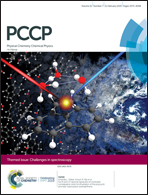Solution properties of imidazolium-based amphiphilic polyelectrolyte in pure- and mixed-solvent media†
Abstract
The solution properties of a synthesized imidazolium-based amphiphilic polyelectrolyte dissolved in pure- and mixed-solvent media composed of two aprotic polar solvents (N,N-dimethylacetamide (DMAc) and N-methyl-2-pyrrolidone (NMP)) having a similar dielectric constant are explored in the semidilute regime (1–4 wt%). Rheological characterizations reveal that the use of mixed-solvent media (e.g., DMAc/NMP with 1 : 1 in volume fraction, designated as 1 : 1 DMAc/NMP) leads to a substantial reduction in the solution viscosity while altering the fluid attribute from gel-like (G′ > G′′) to critical-gel-like (G′ ∼ G′′ ∼ ωn, with n ≅ 0.5). To gain insight into these peculiar rheological features, dynamic light scattering analysis of the representative 1 : 1 DMAc/NMP medium indicates that the fraction and mean hydrodynamic radius of the micrometer-sized cluster alter substantially, too. Multiscale static light/X-ray scattering characterizations further reveal that only the NMP and 1 : 1 DMAc/NMP media (and not the DMAc) are capable of producing hierarchical structures of the cluster interior that are beneficial to mesoscale ion conduction, as supported by ac conductivity measurements. Overall, the present findings suggest that an appropriate selection of mixed-solvent media may offer an exceptional opportunity to promote the rheological, structural, and ion-conduction properties of a polyelectrolyte solution beyond the reach of the corresponding pure-solvent media.



 Please wait while we load your content...
Please wait while we load your content...